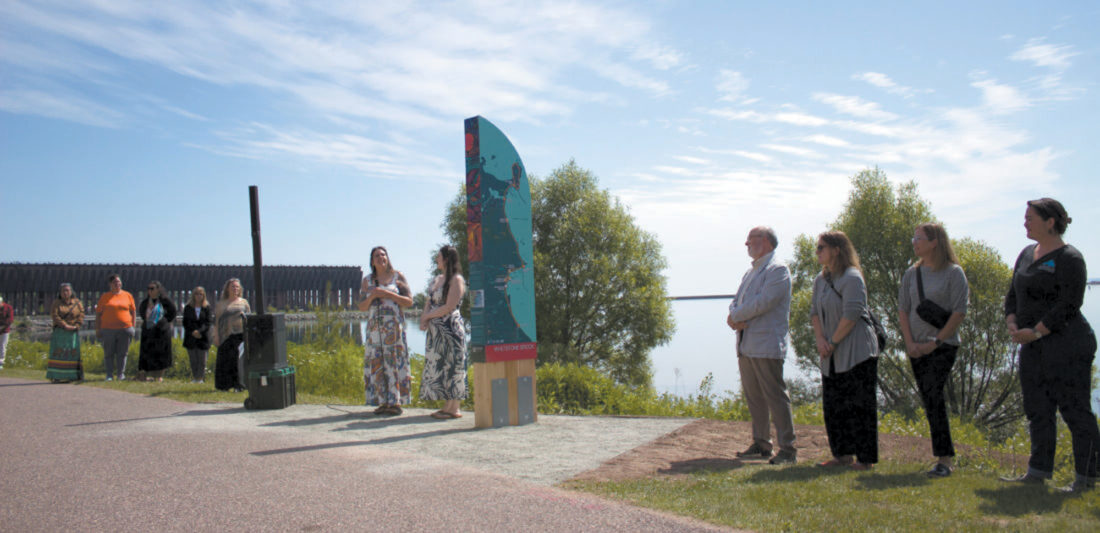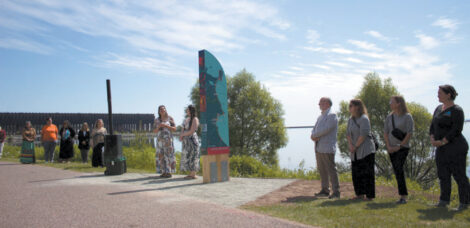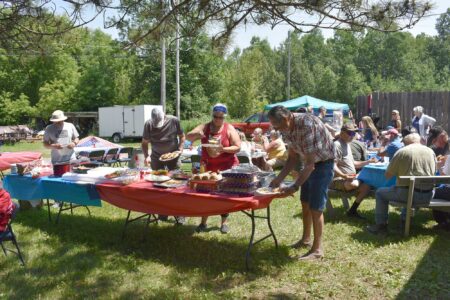Cultural trail in Marquette details area heritage

Sherri Loonsfoot-Aldred and Aiyana Aldred, the artists behind the murals that decorate the markers along the Shoreline Cultural Trail, address the crowd during the trail’s unveiling back in June. (Photo courtesy of the Marquette Arts & Culture Center)
MARQUETTE — At its 10th and final Art Week in June, the City of Marquette unveiled a new feature along Marquette’s waterfront, the Shoreline Cultural Trail.
The trail covers 7 miles of Marquette shoreline, from the mouth of the Carp River to the entrance of Presque Isle Park. A project that’s been in development for nearly a decade, the trail is designed to be a community infrastructure project that supports quality of life and economic vitality in the city, with each of the eight markers inviting community members to actively participate in the area’s culture, history, environment and heritage.
When it comes to descriptive language, the Shoreline Cultural Trail is infrastructure that focuses on being “place revealing” rather than simply an informational sign. The public art pieces that are attached to each sign are removable, which will allow for the city to showcase the work of different artists throughout the area rather than serving as permanent installations.
Sherri-Loonsfoot Aldred, a visual artist also known for her “Mikwendaagozi” oil painting at that used to be at the entrance to Presque Isle Park, and her daughter Aiyana Aldred, a digital artist, created the works of art that are currently on display within each trail marker, using expressive color and a combination of acrylic and graphic techniques.
“You can go in and check with people’s stories as well. There’s an option on the Marquette Compass (webpage) for people to get their stories written. So I’m hoping that our history gets expanded and our influence on this area, and where we came from. That’s what I’m hoping, and I’m hoping to get a lot of this coming down the road because this is just the start of the project,” Loonsfoot-Aldred said during an artist talk where she and Aldred, who are both members of the Keweenaw Bay Indian Community, discussed the specific pieces they created for the cultural trail. “I know a lot of the original families that are actually from the Marquette area, and I want to get their stories. I’m going to go and talk to a lot of them, because not everyone knows to go down there, (scan) the QR code or go online. I’d like to get to a lot of the elders and offer them tobacco and ask them for their stories, for the history of their family from this land, because from what I hear from the younger ones, there’s some pretty interesting stories from the original families here.”
QR codes are present on each of the cultural trail markers, where anyone can scan them and add their own stories relating to the Marquette area, which will be saved online on a webpage so anyone is able to go and view all of the stories from everyone who has a connection to Marquette. Each marker also includes previously known names of the specific area, as well as what the names are in Anishinaabemowin. It’s part of the project’s focus on being “place revealing” rather than place marking, as it helps to unveil stories about the Marquette area that have previously been unknown to both visitors and locals.
“What drew me to that aspect of the project being ‘place revealing’ is that it gives a little bit more agency to the viewer. You, viewing this, get a chance to have the agency or the decision (of) how it makes you feel and you’re less likely to feel like you’re being told what to think,” said Tyler Dettloff, director of the Center for Native American Studies at Northern Michigan University and a contributor to the project. “I think this is great for two reasons. One, locals don’t feel like they’re being told where they live, because they never like that. However, if you can tell locals, or if you can show locals, that there are multiple layers of stories in the place where they live, they can also retain their own identity of this place and incorporate multiple versions of histories, which is our experience. This is our lived experience.”
Dettloff also emphasized the importance of having Anishinaabe heritage and language so prominently visible along the Shoreline Cultural Trail. Some of the sites chosen for the cultural trail – Gichi-namebini-ziibiing (Mouth of the Carp River), Nagomikong and Nayamekang (Gaines Rock and Whetstone Creek), Bagidaabii-neyaashi (Lighthouse Park) and Jiibaay-manidoo-ziibi (Mouth of the Dead River) — serve as prominent markers of Indigenous life and history in the area.
“For me, I think seeing the Ojibwe language so prominently displayed is something that I believe is in line with the Center for Native American Studies at NMU’s mission, to raise the visuals that might act as cultural mirrors for Native Americans in our town and our city,” Dettloff said. “Mostly, on our campus is really what we’re focused on, as the Center for Native American Studies, but this is a really great partnership opportunity between some scholars in our department and the Marquette Arts and Culture Center. To really bring this language to prominence in this place so that people who are visiting from other places that might have more established tribal nations or even tribal housing, they might have community centers that are a little bit more vibrant with populations. If they come (to) visit this place (and) recognize the language, seeing Anishinaabemowin on a sign is going to be much more familiar, or at least invites that chance to relate to this place.”
The Center for Native American studies was one of many core partners contributing to the cultural trail project, alongside the Keweenaw Bay Indian Community, the Superior Watershed Partnership, the Marquette Regional History Center, the Marquette Maritime Museum and the Beaumier U.P. Heritage Center at NMU. The Marquette Arts and Culture Center leads the project, who will continue to coordinate and manage the trail’s programs, physical spaces, and virtual


